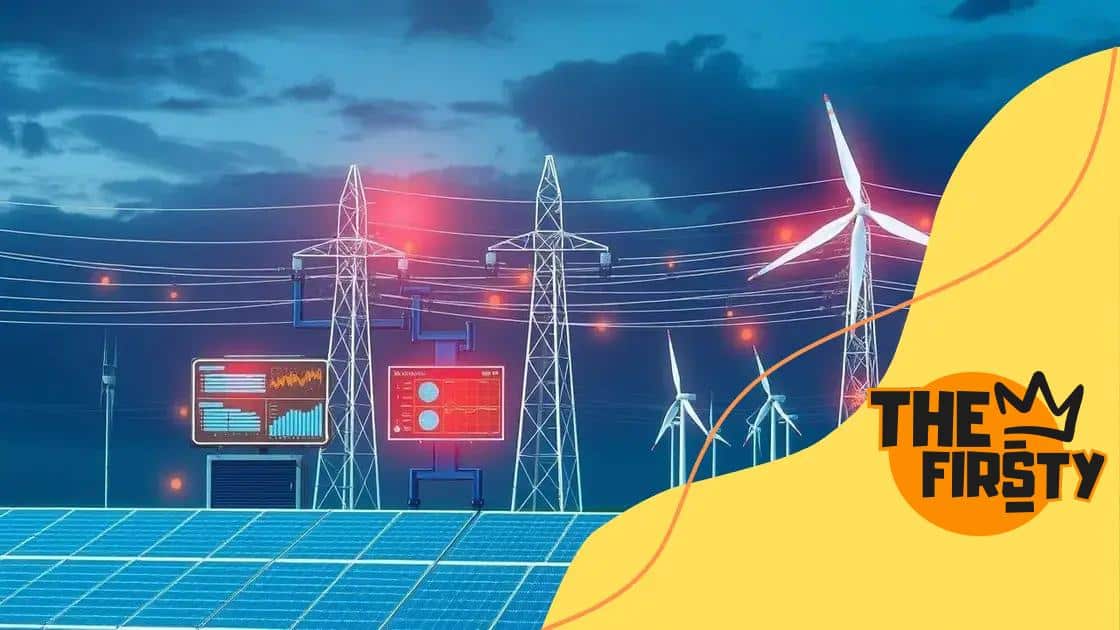How smart cities are using technology to reduce energy consumption

Anúncios
Smart cities leverage technology and data, including IoT and smart grids, to reduce energy consumption, enhance efficiency, and promote sustainability in urban environments.
How smart cities are using technology to reduce energy consumption is reshaping urban living. With increasing energy demands, cities are turning to innovative solutions for sustainability. Curious to see how they’re achieving this?
Anúncios
Understanding smart cities and their goals
Understanding smart cities is essential to grasp how they aim to improve urban living. Smart cities utilize technology to create efficient systems that make cities more livable, sustainable, and connected. By integrating data and technology, these cities can better manage resources and enhance quality of life.
At the core of smart cities are their main goals. They strive to reduce energy consumption, improve transportation efficiency, and optimize public services. Each goal is interlinked, creating a comprehensive approach to urban planning. As cities innovate, they increasingly focus on collaboration and community engagement.
Goals of smart cities
Smart cities pursue several key objectives:
Anúncios
- Energy efficiency: Implementing solutions that cut down energy waste.
- Transportation improvement: Enhancing public transport and traffic management.
- Public services: Streamlining services like waste management and water supply.
- Community connection: Fostering active citizen participation through technology.
Through the lens of these goals, we see how technology serves as a backbone. For instance, smart grids utilize real-time data to optimize energy distribution, reducing waste. Likewise, sensors can monitor traffic flows, leading to better urban mobility.
In addition to goals, smart cities emphasize sustainability. This commitment involves using renewable resources and reducing environmental impact. By investing in green technologies, smart cities can promote a healthier living environment.
As urban areas continue evolving, understanding smart cities helps us appreciate their role in shaping the future. They embody a vision of interconnectedness, where technology meets daily life to create more efficient, vibrant urban spaces.
Innovative technologies for energy efficiency
Innovative technologies for energy efficiency are essential in the quest to reduce energy consumption in smart cities. Cities are integrating advanced solutions to optimize energy use, aiming for a sustainable future. These technologies not only benefit the environment but also enhance the quality of life for residents.
One key area is the use of smart meters. These devices provide real-time data on energy usage, allowing users to monitor and reduce their consumption. With smart meters, individuals can adjust their behavior based on their energy consumption patterns. This awareness leads to more conscious energy choices and decreased utility costs.
Renewable energy sources
In addition, smart cities are increasingly harnessing renewable energy sources. Solar panels and wind turbines provide cleaner alternatives to fossil fuels. By investing in these technologies, cities can not only reduce their carbon footprint but also become less reliant on traditional energy grids.
- Solar energy: Solar panels can be installed on buildings to generate power locally.
- Wind power: Wind turbines capture kinetic energy and convert it into electricity.
- Energy storage: Batteries store excess energy for use during peak demand.
An essential component of energy efficiency is smart lighting. Cities are replacing traditional street lights with LED lights that automatically adjust based on surrounding light levels or pedestrian traffic. This leads to significant energy savings.
In addition to lighting, smart buildings are designed with energy efficiency in mind. They use automated systems to control heating, ventilation, and air conditioning, ensuring that energy is used only when necessary. These buildings often include sensors that detect occupancy and adjust systems accordingly.
With an emphasis on innovation, smart cities continuously explore new technologies. From geothermal systems to demand response programs, the exploration for effective solutions is ongoing. Each new development helps move cities towards greater energy efficiency and a sustainable future.
Impact of smart grids on energy consumption

The impact of smart grids on energy consumption is profound and transformative. Smart grids use advanced technology to enhance the reliability, efficiency, and sustainability of electricity supply. These systems integrate two-way communication between utilities and consumers, allowing for better energy management.
One major benefit is real-time monitoring. Smart grids provide data that enable both consumers and utility companies to track energy usage instantaneously. With this information, users can make informed decisions on when and how to consume energy, leading to significant reductions in waste.
Benefits of smart grids
Some key benefits include:
- Peak load management: Smart grids help manage energy demand during peak hours, preventing overloads.
- Integration of renewables: They effectively incorporate renewable energy sources, helping to reduce reliance on fossil fuels.
- Enhanced reliability: With constant monitoring, maintenance issues can be addressed proactively.
- Improved consumer engagement: Users gain access to tools and insights that encourage energy-saving behaviors.
This proactive approach significantly reduces energy consumption. When consumers are aware of their usage patterns, they often adjust their habits, such as running appliances during off-peak hours. Moreover, smart grids can automatically adjust energy flow based on demand, optimizing overall energy distribution.
Furthermore, smart grids contribute to sustainability goals. By facilitating the use of clean energy and reducing wasted energy, they play a crucial role in cutting carbon emissions. Cities adopting smart grid technology are making strides towards a greener future.
Overall, the impact of smart grids goes beyond energy savings. They enhance the entire energy ecosystem, increasing efficiency while lowering environmental footprints. As more urban areas embrace this technology, the positive effects on energy consumption will only continue to grow.
Role of IoT in monitoring and managing energy use
The role of the Internet of Things (IoT) in monitoring and managing energy use is crucial in today’s smart cities. IoT devices collect and share data, providing insights into energy consumption patterns. This information helps both consumers and energy providers make informed decisions to enhance efficiency.
With sensors placed throughout homes and businesses, IoT technology can track how much energy is being used at any given time. This real-time data enables users to see where they can cut back on unnecessary energy usage. For instance, smart thermostats can learn from user behavior and automatically adjust heating and cooling to optimize energy efficiency.
Benefits of IoT in energy management
Implementing IoT for energy management brings several advantages:
- Data-driven insights: IoT devices provide valuable information that can lead to better energy-saving strategies.
- Automated controls: Systems can adjust energy consumption based on real-time data, reducing wastage.
- Predictive maintenance: IoT can forecast equipment failures before they occur, improving efficiency and reliability.
- Increased engagement: Consumers can actively participate in energy management through apps and dashboards that show their current usage.
As IoT technology evolves, its ability to manage energy use becomes more sophisticated. Smart meters, for example, not only record energy consumption but also communicate with devices in a user’s home. This interaction allows for the optimization of energy distribution based on demand.
The integration of IoT with smart grids further enhances energy management. Smart grids can adjust energy flow based on real-time data, ensuring that supply meets demand efficiently. By combining these technologies, cities can significantly lower their overall energy consumption and reliance on non-renewable resources.
In summary, the use of IoT in monitoring and managing energy use is essential for creating sustainable urban environments. It enables energy-efficient practices that benefit both consumers and municipalities, paving the way for a greener future.
Case studies of successful smart city implementations
Case studies of successful smart city implementations highlight innovative approaches that cities worldwide are using to enhance urban living. These examples demonstrate how technology can be utilized to create efficient, sustainable environments. Each case provides valuable insights into effective strategies and critical lessons learned.
One notable example is Barcelona. The city has implemented smart solutions across transport, energy, and waste management. With smart sensors collecting data, Barcelona has seen improvements in traffic flow and reduction in energy consumption. The integration of smart lighting reduces energy use while maintaining safety.
Singapore’s smart initiatives
Another impressive case is Singapore. The city-state has focused on using digital technology to facilitate better governance and urban planning. Its famous “Smart Nation” initiative uses data analytics to improve city services and infrastructure. With smart mobility solutions, residents benefit from efficient public transport, reducing congestion.
- Traffic management: Real-time data helps manage traffic signals and alleviate congestion.
- Waste management: Smart bins monitor waste levels and optimize collection routes.
- Energy savings: Incorporation of smart grids allows for better energy distribution and usage efficiency.
Meanwhile, Amsterdam serves as an excellent example of sustainable practices in smart city development. The city promotes electric vehicles and bike-sharing programs, reducing greenhouse gas emissions. Amsterdam applies smart technologies for monitoring air quality, providing crucial data for environmental policies.
Additionally, the city has invested in green infrastructure to enhance resilience against climate change effects. Its initiatives reflect how smart technology can harmoniously align with sustainability goals.
These case studies illustrate the power of smart city technologies in transforming urban landscapes. By studying these successes, other cities can adopt and tailor strategies that fit their needs, ultimately creating a more sustainable and efficient future.
FAQ – Frequently Asked Questions about Smart Cities and Energy Efficiency
What are smart cities?
Smart cities are urban areas that use technology, data, and IoT to enhance services, improve quality of life, and promote sustainability.
How do smart grids improve energy efficiency?
Smart grids use real-time data to optimize electricity distribution, manage demand, and integrate renewable energy sources, resulting in reduced energy waste.
What role does IoT play in energy management?
IoT devices monitor energy consumption, provide insights, and automate systems to improve energy efficiency for both consumers and utilities.
Can I learn from other cities’ smart implementations?
Yes, studying successful case studies from cities like Barcelona, Singapore, and Amsterdam can provide valuable insights and strategies for implementing smart technologies.





